Feds demolish more lighthouse site heritage at Point Petre
Administrator | Oct 16, 2022 | Comments 1
The pile of rubble from Thursday’s demolition of the radio beacon navigation building at Point Petre.
In what is becoming an all too common occurrence in Prince Edward County, demolition of heritage, and maritime history, continued late last week, despite requests to cease and desist until, at least, public consultation could take place about the lighthouse complex at Point Petre.
A written plea this summer to the federal government, specifically to the Minister of the Environment by Prince Edward County Mayor Steve Ferguson following the demolition of the lightkeeper’s cottage, appears to have fallen on deaf ears.
The letter encouraged the Ministry of the Environment and Climate Change Canada (MECCC), and its department, Parks Canada, to prioritize the conservation of the Point Petre lighthouse and the radio shack under the Heritage Lighthouse Protection Act (HLPA).
Just two days before a scheduled guided public heritage walking tour, escorted by a member of the MECCC, the federal government brought in heavy equipment to reduce to rubble, the radio beacon navigation building, known as the radio shack on the Point Petre Lightstation site, without notice, warning or any public consultation, nor any form of engagement with local heritage or conservancy groups.
While the Prince Edward County branch of the Architectural Conservancy of Ontario (ACO PEC) was aware the building was slated for demolition, the timing was unknown and not shared with anyone, including the mayor and the municipality.
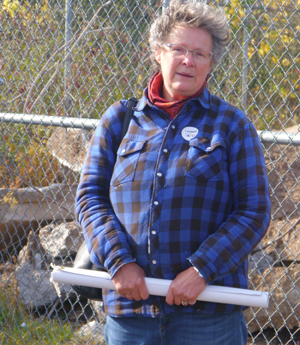
Liz Driver, president of ACO PEC, in front of the rubble from the former Radio Shack
Liz Driver, president of ACO PEC, was on site Friday, but there was nothing she could do to stop the heavy equipment from flattening the heritage building.
Driver noted over many years, the Point Petre Lightstation site on the County’s south shore has become a special place for the people of Prince Edward County, one full of meaning and long, on-going history.
“Now the federal government, having received a letter from the ACO PEC, having received a letter from the mayor of Prince Edward County, having received a phone call or some kind of communication or email from the office of our M.P. Ryan Williams…what do they do? Nothing!” said Driver.
“They didn’t respond; they gave no official response to our group, which is a provincial group established since 1933. It didn’t give a response to our mayor, and it never explained what they were going to do, to our M.P.”
Ironically, Driver pointed out while the federal government was keen to destroy this heritage building, and a part of the County’s history, it was generous enough to salvage a few items from the structure in the form of a fridge and a few other largely worthless, and easily replaceable items which were covered in a tarpaulin adjacent the rubble piles.
The Point Petre Lightstation site, situated on the southern-most tip of the County, is located at 324 Point Petre Road, off County Road 24. The federally-owned site – fenced (with barbed wire) and padlocked – is inaccessible to the public
“A lighthouse site is one place that really brings nature and culture together,” said Driver. “We wouldn’t have constructed the lighthouse, or the lightkeeper’s dwelling, or the radio shack, if it hadn’t been the most southern point of Prince Edward County with all these waves crashing in.”
Built in 1959, the radio shack housed the radio navigation equipment for the newly-opened St. Lawrence Seaway (which opened in 1956). It housed the radio equipment for the once-essential radio beacon navigation system.
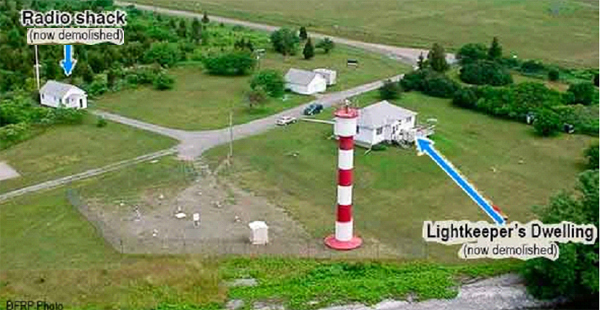 “The radio shack is an historic structure closely related to the Point Petre lighthouse and the marine heritage of Prince Edward County,” said historian Marc Seguin, who is also a director with the ACO, and executive member of ACO PEC, and executive director with Save our Lighthouses.
“The radio shack is an historic structure closely related to the Point Petre lighthouse and the marine heritage of Prince Edward County,” said historian Marc Seguin, who is also a director with the ACO, and executive member of ACO PEC, and executive director with Save our Lighthouses.
In July, in a similar move, the federal government willfully tore down the lightkeeper’s dwelling, built in 1962, again without warning and without any public consultation, and this despite repeated assurances from government officials over the years the site was eligible for protection under the 2008 federal Heritage Lighthouse Protection Act (HLPA).
After the demolition of the lightkeeper’s dwelling in July, Driver and Seguin participated in a phone call facilitated by Natalie Bull of the National Trust for Canada, with three Parks Canada representatives regarding the heritage complex, according to the most recent ACO PEC media release.
Driver and Seguin were assured that an official response letter was currently being written and would be sent to ACO PEC, but no communication was ever received.
The ACO PEC has subsequently learned that the Point Petre lighthouse is no longer eligible for heritage protection under the Heritage Lighthouse Protection Act.
Organized by the newly-formed Prince Edward County branch of the Architectural Conservancy of Ontario, Saturday’s scheduled public tour of the Point Petre Lightstation Saturday started off with sadness with the news that yet another of the heritage buildings had just been demolished.
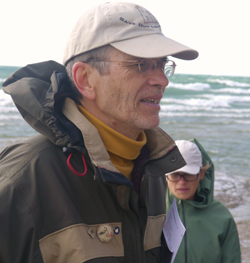
Local historian Marc Seguin
Led by historian Marc Seguin, the sold-out tour of 30 participants, aimed at highlighting this important site, and bringing attention to saving the small complex of buildings for their historical and maritime significance, but also to conserve the site and look at ways to re-use the site for community use.
The mission of the ACO PEC is to encourage the conservation and re-use of Prince Edward County’s heritage structures, cultural heritage landscapes and shorelands.
The ACO PEC hoped the site could be eventually be opened up to the public, with the remaining buildings repurposed.
Present on the tour was Diane Chin, president of the Architectural Conservancy of Ontario who travelled from Cobourg for the event, local historian Peter Lockyer, as well as the daughter of the last Point Petre lighthouse keeper who remembers growing up on site when her father was the lightkeeper.
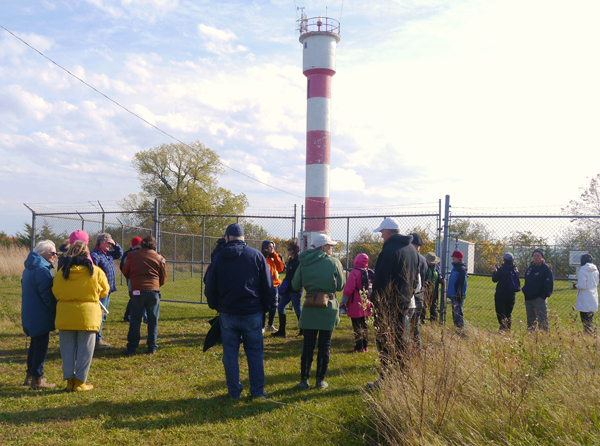 As Saturday was a cool, damp and very blustery autumnal day, waves crashed ashore aided by high winds and the exposed coastline of Point Petre provided an inkling of what mariners in centuries past may have encountered on these often rough waters.
As Saturday was a cool, damp and very blustery autumnal day, waves crashed ashore aided by high winds and the exposed coastline of Point Petre provided an inkling of what mariners in centuries past may have encountered on these often rough waters.
“It’s great day to be viewing the lake when it’s really high like this, and it gives you an idea of what mariners out on the lake in the 19th and 20th centuries had to go through,” expressed Seguin.
Ownership of the overall site is a complicated one since different areas are owned by different government departments, including the Department of Fisheries and Oceans, and also Environment Canada.
Four areas of the site were explored during the exclusive tour, including the current functioning lighthouse, the just-demolished radio beacon navigation station and the recently-demolished lightkeeper’s dwelling, as well as the site of the original limestone lighthouse.
Built in 1962, the site of the last lightkeeper’s house was the first port of call on the tour, where Seguin noted it was third house built on the site (the previously two smaller houses are long since gone).
“It was used as a home for somebody, not always a lightkeeper, but it was used as a home until 2012,” explained Seguin, referencing the third lightkeeper’s dwelling.
He said after the lighthouse no longer needed a keeper, the building was used by Environment Canada.
“There was one guy who would monitor the atmospheric monitoring station, which is at the back of the property, and he lived here until 2012,” said Seguin. “Then they boarded up the building and eventually tore down the building altogether.”
Seguin notes the building was torn down even though it was scheduled, along with the lighthouse and the other buildings on the site, to be protected under the Heritage Lighthouse Protection Act.
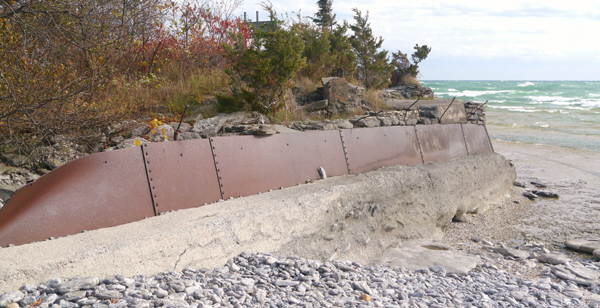
Site of the original Point Petre lighthouse and the most southerly tip of Prince Edward County.
Next on the tour was the site of the original limestone lighthouse located right on the shoreline, where the waters of Lake Ontario abut the land on two sides. With just a wall remaining, Seguin explained Point Petre is the most southerly point in Prince Edward County.
Constructed in 1832, the first lighthouse was active from 1833, remaining in service until 1968 when the 137-year-old structure was blown up with dynamite in 1970, despite protests from local community groups. Today, a mound of rocks is all that remains.
Seguin noted it was deemed of no historical or architectural significance by the Historic Sites and Monuments Board at that time (in 1970).
At the very point of the site of the former first lighthouse once existed a fog alarm station where the horn was situated.
“That was the start of the major demolition at Point Petre, and the demolition has continued throughout the decades.”
He explained the shoals extend two kilometres from shore, and is the reason why the light house was built in the first place, to keep ships away from the shoals.
In the 19th century, this area was one of the busiest shipping lanes on Lake Ontario, and is where a lot of the vessels sank or were wrecked, explained Seguin.
“It’s the reason why this area became known as the graveyard of Lake Ontario,” he said.
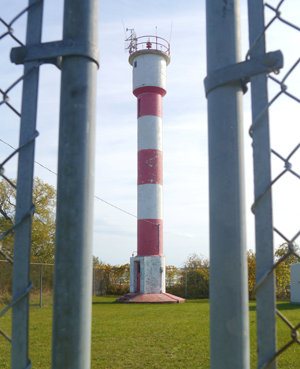 Built in 1967, the current reinforced concrete light tower, distinctive with its red and white stripes, replaced the demolished 1833 structure and is unique according to Seguin.
Built in 1967, the current reinforced concrete light tower, distinctive with its red and white stripes, replaced the demolished 1833 structure and is unique according to Seguin.
“It’s basically a giant pipe, it’s hollow in the middle with a series of ladders going up to the light,” he explained. “This is the only one of its kind in the world, and the only one still in active service.”
There were only two lighthouses of this kind in Canada, the other being near Quebec City on the St. Lawrence.
Separately fenced off and inaccessible, the lighthouse’s once vibrant colours are now faded with flaking paintwork visible, even from a distance away.
“When I first saw this building in 2010, the paint on it was bright red, there was a pristine looking tower,” observed Seguin. “Now you look at it and it is quite faded; not only is the paint peeling, but some of the concrete is spalling and that is a serious problem.”
He said there is also an issue with some of the openings, where some of the vents and windows near the top have deteriorating concrete, allowing the weather to get in.
“If the weather gets into any building, the building will deteriorate quicker and quicker. This building needs to be protected and this whole complex needs to be open to the public, so they can appreciate some of our marine heritage that is quickly being lost.”
The lighthouse, still an active aid to navigation, is the only heritage building left on the site. The beacon, standing 62-feet atop the tower, projects about 16 kilometres out into the lake (19 kilometres on a good day).
“It also deserves to be protected,” stated Seguin. “However, there is no heritage designation or status on this building whatsoever.”
It’s future is at risk, uncertain and unknown.
“There are no plans to demolish it, as far as we know, but for 10 years, they have been telling us that all of these buildings will be saved, so we really don’t know.”
Seguin further explained that if the government decides to declare the lighthouse surplus, there is a known process to go through for community groups to take control and conserve it.
“That was the process this lighthouse was going under (the Heritage Lighthouse Protection Act), but as soon as they declared this lighthouse non-surplus earlier this year, that option was taken off the table.”
He said once it is declared surplus again, should that happen, there will be an opportunity for a public group to obtain it.
“They could come in here one day, build a skeleton tower next door and just demolish this, without any prior public consultation” he said. “They have done that in many places across Canada, because lighthouses like this are expensive to maintain; it’s much cheaper to build a tall skeleton tower, which are maintenance free, and it’s a lot cheaper for them to do that than maintain this lighthouse.”
Liz Driver (ACO PEC president), Marc Seguin (ACO board member) and Diane Chin (ACO president) in front of the just-demolished radio beacon navigation station.
The fourth and final stop on the tour was the site of the radio beacon navigation building, demolished just two days prior.
Seguin explained that when the modern St. Lawrence Seaway was opened in 1956, additional aids to navigation were being installed because they didn’t want to rely just on lighthouses.
“They started to install non-directional radio beacons and a radio beacon used as a navigational device will project hundreds of kilometres (versus less than 20 kilometres for a light beacon).”
Another radio beacon also existed on Main Duck Island.
“Usually, with these radio beacons, a ship tapped in to figure out what direction, relative to his ship, is that lighthouse. And under certain circumstances he could also determine the range.”
The radio beacon was set up at Point Petre in 1959 and the radio equipment was housed in the radio shack. That building would have provided the opportunity to re-use the entire site and now that opportunity is gone, said Seguin.
“Our hopes are not completely dashed because we still hope to be able to have this site open to the general public, so that they can appreciate part of the marine heritage that is left, the important site of the lighthouse and the existing lighthouse.”
“Right now, the ACO and Save our Lighthouses are advocating to have a community voice and get that consultation, so that we can try to stop this kind of needless demolition in the future.”
He reminded that the municipality, while supportive in ACO PEC’s attempt to save the site, has no jurisdiction or authority over this federally-owned site.
In the release, Driver again points to the failure of the government of Canada to consult with the municipality of Prince Edward before demolishing heritage buildings of significance to the community.
While the radio shack is lost, Driver would like the conversation to continue.
“If our branch (ACO PEC) works together with our municipality, and our MP, to have the government speak to us about making the site accessible; to commemorate, to remember all the families that have worked and lived here, all the people who lost their lives even,” said Driver.
“Lighthouses and their related buildings, especially the Point Petre Lighthouse complex, were not only essential aids to navigation around Prince Edward County’s dangerous points that jut out into the eastern end of Lake Ontario, but also significant elements of the landscape and the County’s cultural heritage” she stated.
“The entire site is of great cultural heritage significance to all Canadians as it is one of the region’s last remaining vestiges of Canada’s once-vital marine history, which contributed so much to the development of the country from the 19th century through to the present day.”
“The Point Petre lighthouse complex is of great cultural significance to the community and should be preserved for future public access and adaptive re-use,” she added.
Click here for the Save our Lighthouses website
Click here for more stories about Prince Edward County lighthouses and efforts to save them
Filed Under: Featured Articles • Local News
About the Author:

































Destroying rather than conserving these buildings is such an asinine decision that it is impossible to ignore extragovernmental dysfunction. Clearly, the federal government is completely out of touch with its citizens’ desires. There needs to be much better, timelier and easier lines of communication than those that currently exist.